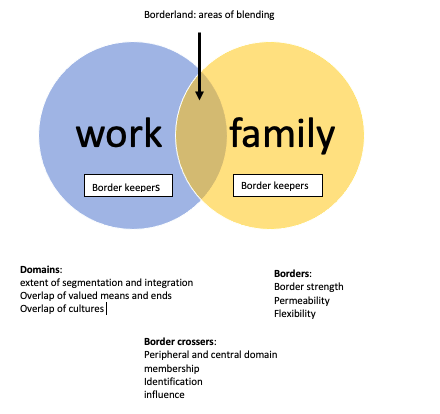Chapter 9: What Boundaries? Technology’s Role in Work and Family Balance
No is a complete sentence.
― Anne Lamont
Chapter Insights
- Work is an external system influence on families.
- Boundary theory is often used to describe work-family balance. Basic ideas in the theory include terms like boundary permeability, negative or positive spillover and boundary keepers.
- Consider this statement: “Technology is theoretically neutral and does not dictate boundary permeability.” Do you agree or disagree?
- The are many ways ICT is used in work-family balance. It can influence – positively or negatively — family satisfaction, workplace performance and individual’s mental health.
- The term “new ways of working” is used to describe more flexible arrangements for work. Consider generational differences in the desire for flexibility and these new work arrangements. Consider too what flexibility and work arrangements means in studies that reveal challenges to the individual’s mental health.
- A review of the research presented in this chapter. The picture it paints is quite complex and unclear. What does that tell you about the question of technology’s influence on work-family balance?
- The video interview with Simon Sinek presents a fairly strong opinion about how well Millennials and GenZers were prepared for the workforce, and the need for companies to accommodate. After viewing the video see if you agree. Or perhaps your thoughts are less black and white on this issue.
- Our collective experience using ICT during the COVID-19 pandemic may have shifted perspectives about work and family balance. After your own experience with school/work/home life during COVID-19, consider your thoughts about the role, influence and value (and perhaps consequences) of information and communications technology.
- Policy recommendations organizational action are listed in the chapter. How might businesses and universities (as a business and an institution that helps prepare future professionals) support individual’s acquisition of “digital cultural capital”?
- Given predictions of new ways of working and potential impacts on individuals and families, there are new roles that family professionals can and should play in aiding families now and in the future for maintaining a healthy balance.
- After reading this chapter, identify what you feel inspired by, the questions that remain for you, and the steps you can take for your own technology use to be more intentional.
Introduction
If COVID-19 brought families anything positive, it was the ability to complete multiple responsibilities in a single location and with fewer constraints on time. Many families were home-bound, and thus needed to attend to work, school, interests, religious fulfillment, caregiving, and other matters from home. They relied on the internet and digital communication tools as they had before the quarantine, but this time without the traditional bounds of place and time.
These images captures what it was like for many:
 |
 |
These mothers are juggling multiple responsibilities, accommodating attention across needs, and using technology to fulfill demands. When you look at these images, what emotions arise for you? How do you think the mothers feel? How about their children? Imagine yourself in a similar situation. Demands pile up across work/school/activities and in your personal/family/friend life. And somewhere in the middle are the intentions you have for your health and well-being (sleep, anyone?).
The concept of work-family balance (or other balance of role demands) relates to the satisfaction that results when an individual, as a member of a family, competently straddles role demands across the spheres of the household and workplace (and often additional domains). Our interest in work and family balance isn’t new. Scholars have long been researching and theorizing about the ways in which individuals can successfully balance their attention, energy, and focus across roles in multiple spheres, with success having many implications. Scholars have long been researching and theorizing about the ways in which individuals can successfully balance their attention, energy, and focus across roles in multiple spheres, with success having many implications. Workplaces vary, as do work demands. For some families, balance results from tightly bounded dimensions (e.g., the 9-to-5 external workplace and the family home); for others, the integration of work life and family is more seamless or more complex, such as when work responsibilities lie in a family-run business. Over the decades, changes in parents’ work patterns — particularly with increased participation by women in paid work, increased work hours, and non-standard/atypical work hours (time spent working outside of the workplace) — raised interest in the topic by scholars. And in the last 20 years, access to the internet and the advent of mobile devices has exponentially made study of work-family balance more complex.
Perspectives on Work-family Balance
Boundary theory is frequently used to explain the dynamics of work-family balance and to identify antecedents and consequences (Berkowsky, 2013; Olson-Buchanan et al., 2016; Nam, 2014; Rice, 2017). Boundaries of time and space, in particular, are seen as either fixed or permeable in reinforcing or allowing fluidity in the execution of role demands. Physical spaces and the persons in those spaces — the boundary keepers (e.g., employers, family members) — help reinforce boundaries by laying explicit and tacit expectations on the individual for role fulfillment.
 Work-family balance and boundary theory. Adapted from Clark, 2000.
Work-family balance and boundary theory. Adapted from Clark, 2000.
Clark’s (2000) discussion of boundary theory as it affects families observes that differences in the balance experience are characterized by degrees of permeability in boundaries and flexibility in the execution of work/family roles. Permeability indicates whether “elements from one domain are readily available in the other; the ability to be physically in one setting yet perform a role psychologically from another” (p. 1020). A father who calls to check on his children who are home after school is demonstrating that the boundary of the family is permeable as the demands of his role enter the workplace. This is the result of his work conditions and his psychological separation from work to make the phone call.

Flexible boundaries occur when “a person could relax the boundary to meet the demands of the other domain,” and when spatial and temporal markers of a boundary can be moved (Nam, 2014; p.1020). For example, when a teacher grades papers over the weekend, and at home, the work boundary is flexible. The responsibilities of work are completed in a home-based (or other) setting. Boundary crossing occurs when there is some level of integration: high permeability and high flexibility, or high flexibility and low permeability, offer autonomy (the choice for role completion in one domain or another); low flexibility and high permeability result in interference (higher probability of roles enacted in one domain to the exclusion of the other), and low flexibility and low permeability mean segmentation (or boundary keeping). Nam observes that individuals with the potential for interference are more likely to suffer the consequences of heavy workload, more stress, and diminished satisfaction.
Transfer, or spillover, occurs when the individual’s mood resulting from handling demands in one sphere affects the other. Spillover can be negative (e.g, work stress taken out on others at home) or positive, also known as enrichment (e.g., getting a promotion at work positively affects the parent’s mood at home). Berkowsky (2013) refers to this as cross-domain compensation. Competencies gained in multiple roles can also help the individual deal with the negative stresses associated with roles in one domain. A parent who receives a positive review at work, for example, may carry that feeling of competence in to their childrearing attitudes. Recovery periods return the sense of balance and individual well-being after experiencing and then resolving work-family conflict (Demerouti et al., 2014).
There are traditionally three domains of interest when studying work-family balance: the workplace, the family, and the individual. Studies may also examine the wider influence of balance on society (reviews by Olson-Buchanan et al., 2016, and Rice, 2017, indicate potential impacts on society; Shockley et al., 2018, provide a cross-cultural perspective). An example of a societal benefit is when the workforce is solid as the result of contented employees who feel that they successfully can balance responsibilities across domains. Family, individual, and work outcomes reflect comprehensive and systemic impacts. More work hours, for instance, may mean greater work productivity, yet also more role strain, personal stress on the individual, and family dissatisfaction.
Based on a review of the international literature, Wheeler et al. (2018) recognize secondary effects. Most often, parents’ stress from conflict or imbalance influences children through their own psychological functioning and relationships. Children’s mental health and/or achievement can be affected. They cite cross-family differences in cultural orientation, including gender equalitarianism, and intrafamily (between parent) differences in occupational profiles that may reveal differences in child impact.
Some of the outcomes studied when considering work and family balance:
| Family | Individual | Workplace | Society |
|
Satisfaction with personal relationships Family satisfaction/conflict |
Physical and mental health
Use of prescription medications Perception of stress |
Work productivity
Work satisfaction |
Percentage of women in the workforce |
| Secondary:
Children’s mental health Children’s academic achievement |
The ability to balance roles may be viewed as a skill possessed by the individual, when in fact a complexity of influences affects the ways in which balance is achieved (Shockley et al., 2018). Working parents in countries with high rates of inequality and low rates of economic growth and inflation, for example, value the opportunity for longer working hours, so their perception of stress from work hours will be different. The perception of conflict also appears to be influenced by culture (Shockley, et al, 2018; Xu et al., 2018). Countries with more collectivistic cultures view family-to-work conflict as less of an issue; because work is perceived as a means to provide support for and honor the family, additional work and longer work hours are seen less as a conflict and more as helping the family. The perception that longer work hours create conflict in the family is more likely in countries with a more individualistic worldview.
Gender equality and supports to the family play a significant role in demonstrations of balance. Because women take more responsibility for domestic housework and child caring, it is harder for employed mothers to achieve balance without additional child care. Higher rates of family vs. work conflict are seen in countries that have a wide gender gap (Shockley et al., 2018). Disparities also occur across education lines. In the response to COVID-19 pandemic, many workplaces offered extended leave and benefits for child care. Additional benefits such as flexible or reduced hours, paid/unpaid time off, and child care or tutoring benefits favor those with higher levels of education (Miller, 2020). For example, 29% of those with post-graduate degrees report paid time off, compared to just 9% of those with less than a college educationt.
Even with the availability of work-family policies in recent decades, a backlash has challenged their success. Perrigno et al. (2018) observe four mechanisms at play in the effort to sabotage well-intentioned work-family policies: 1) inequity, 2) stigma, 3) spillover, and 4) strategy. One can imagine that integrating ICT in the workplace and attempting balance with family responsibilities only makes policy action even more complex and challenging.
Moving forward, readers are cautioned about extant research on work-family balance. Focusing only on the existing body of research about worker and family experiences can lead to overgeneralization. Too often, there is a tendency for research to reflect the experiences of those who are “WEIRD” (Western, educated, industrialized, rich, and democratic).

Technology Integration and Work-Family Balance
While ICT has long played a role in in cross-boundary role maintenance (e.g., the mother who uses a phone to check on her children after school), mobile technologies and virtual environments can seem to practically evaporate boundaries of time and place in how and when work gets done. In fact, the fluid nature of work due to the use of technology across boundaries in the last 20 years leads Hughes and Silver (2020) to assert that, rather than seeing work and home in balance, how work gets done should be seen as the new standard. Adjustments to family life, with more flexible workplace arrangements, are being embraced as a fact of the future (Anderson et al., 2021).
Technological innovation for the workplace may have tapped into a longstanding need. Rice (2017) observed that many workers do not find that workplace hours accommodate a sense of balance with family responsibilities. She cites a 2010 study in which 60% of Australian workers indicated a preference for telework. And 2017 data indicated that workers would take an 8% pay reduction if it allowed them to work from home (What a way to make a living, 2020). Nevertheless, prior to COVID-19, fewer than 5% of the labor force in the U.S., and 2–9% in Europe, reported exclusively working from home (Eurostat, 2017). These statistics highlight the dramatic effect of the pandemic on a more mobile workplace. Equally, the availability of college courses online shifted exponentially with COVID.
For those whose jobs can adapt to these “new ways of working” (Demerouti et al., 2014), new challenges are present. Studies of teleworking offer insight into the conditions which may contribute to a sense of balance or imbalance. Early research on technology integration indicated positives for worker productivity, and for worker perception of autonomy, yet later work suggested minimal benefit for working from home (Olson-Buchanan et al., 2016, p. 21). In particular, women did not demonstrate higher job satisfaction even if they perceived more control and flexibility. Solis’ (2016) examination of teleworkers in Costa Rica identified that having more work time at home, shared or inadequate space, and inflexible work schedules related to perceptions of work-family interference. In part, the presence of the mother at home, though working, may over time enhance children’s expectations of her availability. Employer attitude also appears to contribute to teleworking success; the actions of managers who are reluctant to trust employees to be productive can diminish employee feelings of autonomy and recognition.
Technological innovation and work arrangements may create further divides among families. Many jobs, however, do not offer flexibility in time or work context or present the autonomy for determining work (or family) interruptions (Olson-Buchanan et al., 2016). This is particularly true in professions requiring skilled labor. Latin American countries like Ecuador, Guatemala, and Bolivia, more greatly dependent on manufacturing or agriculture, have less potential for telework (Pimintel, 2020). This was also evident for essential workers during COVID-19, for whom the need to be present at work and the need for child care support continued uninterrupted.
The internet, and mobile and digital technologies, offer the promise of managing work with more autonomy and success amidst a more fluid landscape of a modern workplace culture that thrives on employee availability (Demerouti et a.l, 2014). Research on technology’s influence on work-family balance before COVID-19 informs our understanding of the adjustments needed as we look to a future that is “tele-everything” (Anderson et al., 2021). Theoretically, perceiving work conditions as more flexible relates to higher job satisfaction. Use of mobile technologies might modify that relationship, however, if workers feel in less control due to communication demands (for example, from an employer during family time).

Research by Nam (2014) examined the influence of internet and mobile phone use on 850 workers’ perceived flexibility and permeability and on job outcomes (job satisfaction, job stress, and workload). Workers’ sense of stress decreased with use of mobile phones for work. Nam found direct (positive) relationships between the use of technologies and perceptions of work and family flexibility and of work-family permeability. And these variables related to each other: permeability of work-to-family life was positively related to flexibility in work-to-family life. In other words, those using technology to accomplish work tasks at home were likely to facilitate home-related needs at work. For some workers, although the use of technology increased workload and perceived stress, it did not change the ability to balance work and family. For others, telework reduced feelings of stress, yet contributed to feelings of being overworked. And effects observed may reflect more than the direct impact on the individual; Ferguson et al. (2016) revealed that using technology to continue work from home can have compounded effects on the employee through influence on the family. They examined cell phone use at home for work by employees (so called “mWork”). An employee’s decision to quit the job in response to heightened workplace demands related to strain that appeared to correlate with strain on family members.
Nam suggested that organizations continue to monitor employee satisfaction with the use of technology. The changing use of technology by employees at work and for work, and for work at home, requires that policies regarding work-life balance consider the growing interplay of technology with flexibility and worker satisfaction.
Antecedents, Outcomes, and Moderators of the Process in Technology and Work-Family Balance: a Complex and Shifting picture
Olson-Buchanan et al. (2016), Ollier-Malaterre et al. (2019), and Rice (2017) reviews research on work-family balance and technology. To help the reader visualize elements in the process, the table below lists variables studied as antecedents (or pre-existing conditions), outcomes, and moderators. These indicate relationship potential between technology use, reasons for use, individual differences, and individualized outcomes. Lending complexity is that the same variable may be conveyed differently depending on the research. Job demands, for example, may be a predictor in one study, influencing whether the use of technology for boundary permeability is necessary, and appear in another as a moderator, affecting the degree to which using technology influences the balance.
| Variable Type | Variable |
| Antecedents (factors influencing technology use for work & family) | Work:
Family:
Individual
|
| Outcomes | Work
Individual
Family outcomes
|
| Moderators | Individual:
External:
Job-related factors
|
Variables identified in technology and work-family balance research
Antecedents. Olson-Buchanan et al.’s (2016) review identified that use of ICTs to perform work during non-work time was positively predicted by perceived usefulness of the technology, along with job conditions (higher job status, work demands, work norms/expectations), expectations from family and friends, and the ability to multitask, and negatively predicted by preference for segmentation (individual difference for boundary maintenance). Rice (2017) similarly determined that use and comfort with technology predicted individual differences in work-family arrangements, which also influenced work and individual outcomes from flex arrangements.
Readers may remember discussion of Davis’ technology acceptance model (TAM, 1989) in Chapter 2. The TAM characterizes use of technology in terms of positive perceptions toward that use. Expectations from the workplace can establish norms about how and when to use technology across boundaries (e.g., the employer who continues to send emails over the weekend with the expectation of response). Individual differences — such as age and comfort with technology (Nam, 2014), gender, marital status, and work position — can influence the uptake of technology use for work-family balance. Millennials are more tech-savvy, yet less flexible with work outside of work settings, even though technologies make that possible. Marital status (and its correlation with childrearing responsibilities) and the demand for role responsibilities at home create the need to use communication devices for coordination. Gender influence appears related to correlative societal and role demands — men with more education, for example, held jobs that enabled more autonomy. And work position influenced the degree to which individuals held boundary permeable/flexible positions that conditioned their use of technology.
Outcomes. A focus on workplace, family, and individual outcomes continues to be present in technology-related research. Work outcome variables include perceived flexibility or control (autonomy), work productivity, hours worked, work-nonwork conflict, psychological strain, and job attitudes. Family outcomes include family connectedness and satisfaction.
Perhaps the largest area of outcomes-research relates to the individual — specifically, dimensions of worker individual health (blood pressure, heart condition, frequency of illness), and mental health (depression, stress, role strain). Longer work hours and the negative spillover felt by family contribute to higher work-nonwork conflict, higher perceived stress, and burnout. The ability to work and meet family needs “any time, any place” can result in tremendous strain on the individual. Yet many families find value in having agency in when and how work and family roles are completed. Rice (2017) also reports that the high-pressure environment of always “being on,” navigating irregular hours, and a potentially unpleasant physical environment can have physical and physiological costs. The review indicates that about half of a U.S. sample agreed that using ICTs increased their stress, the blurring of work-family boundaries, and conflict (p. 186).
Writing about tele-work, Leineweber and Falkenberg (2018) report that Nordic countries have the highest rates in Europe of workers working from home. For these workers, the constant availability offered by new technologies and telework leads to feelings of constant involvement, including during free time. As Olson-Buchanan et al. (2016) observe, “the flexibility of time and space and role demand, aided by the use of boundary cross technologies, fosters role conflict by allowing for interruptions and distractions and hindering one’s ability to meet the demands of the salient role” (p.18).
Social isolation is a potential result of telework or flexwork. Studies have observed that increased online communication has reduced casual conversation between colleagues (e.g., talk around the water cooler), which can then influence work outcomes. While working from home can mean the availability of a parent to care for a child or be present when the child is sick, consistent space and time flexibility can risk compromised productivity. Exploitation of the flexibility by employees to multitask can diminish chances for promotion and opportunities for achievement. This is particularly likely for women, the elderly, and those with children with disabilities, who have competing role expectations on their time. As a result, despite the availability of technologies that offer flexibility, the difficulty of doing both home and work roles well contributes to conflict and possibly weaker work performance.
Moderators. Research on work-family balance also identifies moderators in the individual, work, and family realms. Variables related to the individual include negative affect, time management skills, preference for segmentation, and gendered or personal demands. Those whose time management skills are challenged may use technology across boundaries, yet not feel or be productive…. workplace moderators (of ICT’s influence on perception of balance include technology support and job status. . Educational achievement also predicts flexibility and an openness to using technology across boundaries. Nam (2014) asserts that individuals with more education tend to be more flexible with resources and energy to work in their home life domain. Yet they are also reluctant to let work interrupt their family life. So while they are willing to work from home (demonstrating flexibility), their action is not passive and shows agency in determining boundary permeability.
Moderators in the workplace include social stressors, technology support (or lack thereof), and job-related factors such as job status. Technological support, for example, boosts perceptions of flexibility, indirectly benefitting work satisfaction. It appears to work beyond aiding the individual’s knowledge and confidence in using technology, providing an indirect boost to perceived flexibility and work satisfaction. A study of parent and family educators in the U.S. determined a strong relationship between workplace infrastructure (including technical support) and encouragement (including shared values for technology) and perceived usefulness and ease of use (Walker & Hong, 2017). Taken to its natural conclusion, technological support’s value to individual technology comfort could positively influence competence in use for work-family balance, resulting in reduced work strain and burnout.
Family demands can influence worker attitudes. Workers whose family members have positive attitudes about technology’s usefulness, for example, report higher work satisfaction. But these variables don’t work in isolation. More recent advances in education, integrating technology in children’s school work and learning, have introduced stresses on families as children spend time online and need assistance. A recent study by McKinsey and Lean (2020) observed that, for many women, this can influence the decision to leave their jobs. Justifications include lack of flexibility at work, feeling like they need to be available to work at all hours, housework and caregiving burdens, worry that their performance is being negatively judged because of caregiving responsibilities, discomfort sharing the challenges they are facing with teammates or managers, feeling blindsided by decisions that affect their day-to-day work, and feeling unable to bring their whole self to work. Black women and other women of color experience these constraints to a greater degree.

The future view of work
Looking to the future, experts foresee shifts in work that that will make it less placed-based, more flexible, more automated, and reliant on on-demand consumer expectations (Anderson et al., 2021; NAS, 2017). Ens et al. (2018) identified a digital work typology based on how work is reconfigured through the availability of digital technologies. This typology reflects job mobility (degree of flexibility in the location of work) and precarity (degree of instability due to flexible employment), and it was crafted to construct a notion of “decent digital work,” or digital work that enables autonomy, competence, and belonging (p.2) They label worker types as follows: the gig worker (high precarity, low mobility), the digital nomad (high precarity, high mobility), the 9-to-5er (low mobility, low precarity,) and the traveling elite (high mobility, low precarity). Gig workers take ad hoc, temporary jobs, such as driving for Uber. Digital nomads work at jobs with high precarity but are not fixed to particular locations. A web developer who is mobile and works from different countries, for example, is a digital nomad.
|
Low Mobility |
High Mobility |
|
|
High Precarity |
Gig Worker |
Digital Nomad |
|
Low Precarity |
Nine to Fiver |
Traveling Elite |
Digital Work Typology. Adapted from Ens et al. (2018). Decent digital work: Technology affordances and constraints. Paper presented at the Thirty ninth International Conference on Information Systems, San Francisco CA, USA
These new digital-work realities can affect individual well-being. The transition to more flexibility in location can challenge feelings of competence in managing tasks and time, and the sense of belonging. Consequences heighten with greater mobility (traveling elite) and precarity (digital nomad), threatening the sense of connection. According to the authors, “Autonomy suffers from a need to maintain a steady supply of work and meeting clients’ needs” (p. 6). There exists the potential that spillover from these digital work arrangements can affect the workers’ emotional release at home and the time needed for recovery.
Work-Family Balance Policy Recommendations Reflecting New Digital Realities
In 2021, the author prepared a background report for the United Nations on the role of technology in the family (Walker, 2021), with an emphasis on work-family balance. This section presents an adaptation of the report’s policy recommendations.
A family-focused work-life vision is more relevant now than ever, as the shift to tele-work and the removal of boundaries of space and time appears to predict future realities. Policy recommendations to promote work-family balance in the digital world supplement existing actions to create more flexible hours, leave policies, and supports related to childcare and children’s education. Such policies are far ranging and promote quality early childhood education and childcare for all children.
Recommendations reflecting the integration of technology and work family balance lean heavily on flexibility, yet suggest structure that intentionally guides family, individual, and workplace well-being. A persuasive observation from the existing research is that employee perception of balance and preference factor strongly in technology use, adaptation, and outcomes, so workplace recommendations may allow employees to set their schedules (and work locations) to meet needs in both spheres yet provide them with guidance and follow-through on organizational policy about setting boundaries to lower personal stress and enrich family satisfaction and well-being (Demerouti et al., 2014).
Individual competence in boundary management, however, must also be regarded, to aid in the development of what Ollier-Malaterre et al. (2019) call “digital cultural capital.” Technology has been said to present a paradox through its problematization of work-nonwork boundary permeability. It makes permeability possible, yet creates challenges requiring individual attention and responsibility to provide equitable balance in role performance. “Digital cultural capital” represents the awareness, motivation, and skill to perform technology management. A new employee benefit, for instance, may be tailored educational supports on how to manage ICT to support work and family goals.
Employers can help foster more personal responsibility to avoid negative spillover in setting boundaries for communication — using smartphones wisely, deploying privacy management tools, practicing good digital citizenship and online self-presentation (Olson-Buchanan et al., 2016; Blum-Ross et al., 2018). As Ollier-Malaterre et al. (2019) stress, the development of “digital cultural capital” should be learned through the social class divides that enable some groups to develop skills over others.
Employers can acknowledge individual differences that might affect workers’ abilities to work from home while also supporting their children’s learning (McKinsey & LeanIn, 2020; What a way to make a living, 2020). “Boundary management” may be a new skill employees need to acquire. Providing support may reduce psychological stress and enhance parent/worker confidence, promoting mental health and well-being and potentially making parents more available to assist with their children’s learning from home.

Policies must hold a vision for future innovation and what that will mean to the workplace and to families.
At the same time, employers must be wary of permeability effects on workers. Research suggests that workplace permeability benefits employers more than employees; when individuals lack the capacity to manage demands across work and family spheres, job dissatisfaction, job-related stress, and role overload occur. Policies for employees need to be consistent and clarify expectations for daily work and performance reviews (Blum-Ross et al., 2018). They should also regard individual differences in employee preference and avoid inequity and division. Older workers, for instance, hold different views on autonomy and permeability than younger one. Training and support programs that advance the technology skills of older workers can lessen gaps in worker performance.
Greater responsibility for the privacy and security of a more permeable, flexible work and family life in online spaces must be taken. As Ollier-Malaterre et al. (2019) note:
technology amplifies the blurring…also because the very definitions of what is public and what is private are under scrutiny: Information shared on social media, for instance, is sometimes deemed by scholars and lawyers as private and sometimes public…In an era in which putting up curtains on windows and planting high trees around houses no longer suffices to safeguard privacy, many new questions for individuals arise about privacy, visibility and surveillance that societies or collective actions may at some point strive to regulate. (p. 435)
The reach of organizations expands with technology changes, ultimately affecting individual workers and the blurring of boundaries and roles. Attention needs to be placed on the longer-term exposure to forced teleworking (as with COVID, or permanent shifts made post-pandemic), and considerations necessary for workplace supports that extend to the home. Employers can consider financial subsidies that cover costs for home internet, ergonomic workspaces, and peripherals that make home-based work less taxing on personal resources. Other proactive planning will be for transitions as work-home arrangements change. As employees have flexed and reoriented their boundaries to satisfy work and family needs, a return to previous or adjusted arrangements will bring about the need for recovery (Dermouti et al, 2014) and support (McKinsey & LeanIn, 2020).
Research Considerations
Without a doubt, research on the intersection of work-family balance and technology needs to be expanded — in ways that include a greater representation of workers, work contexts, and family experiences, and that examine how cultural assumptions with regard to technology integration shape work-family policy. The French government, for example, encourages companies to minimize technology disruptions after work hours. This helps to control technological effects at multiple levels (Ollier-Malaterre et al., 2019).
Within the research, attention to individual and family outcomes from technology-integrated work-life balance must be elevated on par with that directed at workplace well-being. A systemic view must regard the reciprocal and transactional costs and benefits to the family, and should include the effects of work-family balance on children, an area that to date has been given limited attention in the literature. Children’s well-being as influenced by parents’ work status and work conditions deserves closer study. Work-family conflict, with its impact on the parent-child relationship (and inherent to this, parents’ attention, communication, and responsivity), appears to be an indirect route through which work-family balance can influence externalizing or internalizing behaviors.
Disparities in work-family policy, and in its equitable execution, exist worldwide. U.S. policies for family leave and childcare support lag behind those of other countries that are economically competitive and have low employment rates. Might there be similar resistance to comprehensive policies that address the complexity of technology preferences, work demands, and the needs of families? In chapter 12 we consider the role of policy in integrating research findings on ICT and the family into the real world. The future of families demands that our critical lens extend to the role technology plays in the peaceful balance of work and family demands and benefits.

